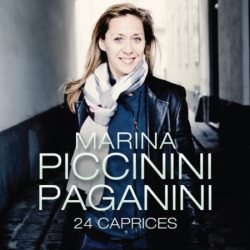| 
|
Niccolò PAGANINI (1782–1840)
24 Caprices Op.1 (arr. Marina Piccinini)
Marina Piccinini (flute)
rec. 10–12 October 2012, Reitstadel, Neumarkt in der Oberpfalz, Germany
Tracklist at end of review
AVIE AV2284 [58:34 + 41:21]
Most, like me, will only know the Twenty-Four Caprices by Paganini in their original violin form. Yet when researching this review I was surprised to find several recordings in the catalogue of flute arrangements of this famous Op. 1. Patrick Gallois has made his own, and there are also recordings by Dora Seres, Bonita Boyd and Julian Cawdrey.
The Caprices have been frequently used as a pedagogical vehicle for the training of flautists since 1902, when Jules Herman, a professor of flute at the Brussels Conservatory transcribed and published them for his instrument.
Whereas Herman’s arrangement is based on a spurious edition of the Caprices where there has been some toning down and smoothing out of the advanced harmonic flow and angularities of Paganini’s original, Piccinini takes as her starting point the Urtext edition of 1820. In the introduction to the booklet notes, she elaborates: "I was drawn to transcribe and record all the Caprices as a challenge and stimulus for my own development, a path towards pushing the envelope outside my personal comfort zone. What I discovered and fell in love with was a musical voice that demanded a far greater emotional expression through technical perfection of phrasing, flexibility of embouchure, depth of sound, breath control, digital dexterity and precise articulation."
Piccinini’s is an impressive virtuosic achievement, underpinned by intelligent musicianship. On display is a great show of resourcefulness and respect for the score. She tackles the violinistic technicalities in a variety of ways. Double-stops are solved either by broken chords or grace notes. Some are omitted, where either of these two solutions adversely affects the shape of the melodic line. Right and left hand pizzicato is achieved by staccato tonguing. Light double-tonguing is employed in No.5 to replicate quick-fire semiquavers. With all of these techniques, it is Piccinini’s intention ‘to remain true to the music’s creative thrust’ with regard to the specific tonal qualities and expressive range of the flute.
Sound quality is excellent, with the recording engineers achieving brightness, warmth and spaciousness around the instrument. I would imagine that this recording would appeal to a limited audience, specifically flute players, in the main. Julian Haydock’s notes provide background and context.
Stephen Greenbank
CD 1
No.1 in E: Andante [3:00]
No.2 in B minor: Moderato [5:02]
No.3 in E minor: Sostenuto [3:44]
No.4 in C minor: Maestoso [9:22]
No.5 in A minor: Agitato [3:08]
No.6 in G minor: Lento [7:34]
No.7 in A minor: Moderato assai (Posato) [5:09]
No.8 in E flat: Maestoso [4:09]
No.9 in E: Allegretto [3:10]
No.10 in G minor: Vivace [3:31]
No.11 in C: Andante [5:15]
No.12 in A flat: Allegro [5:27]
CD 2
No.13 in B flat: Allegro [3:15]
No.14 in E flat: Moderato (Marcia) [1:32]
No.15 in E minor: Posato [3:30]
No.16 in G minor: Presto [1:55]
No.17 in E flat: Sostenuto [5:08]
No.18 in C: Corrente [2:51]
No.19 in E flat: Lento [3:18]
No.20 in D: Allegretto [3:49]
No.21 in A: Amoroso [3:40]
No.22 in F: Marcato [3:34]
No.23 in E flat: Posato [3:09]
No.24 in A minor: Quasi presto [5:36]
 |
 |
|
